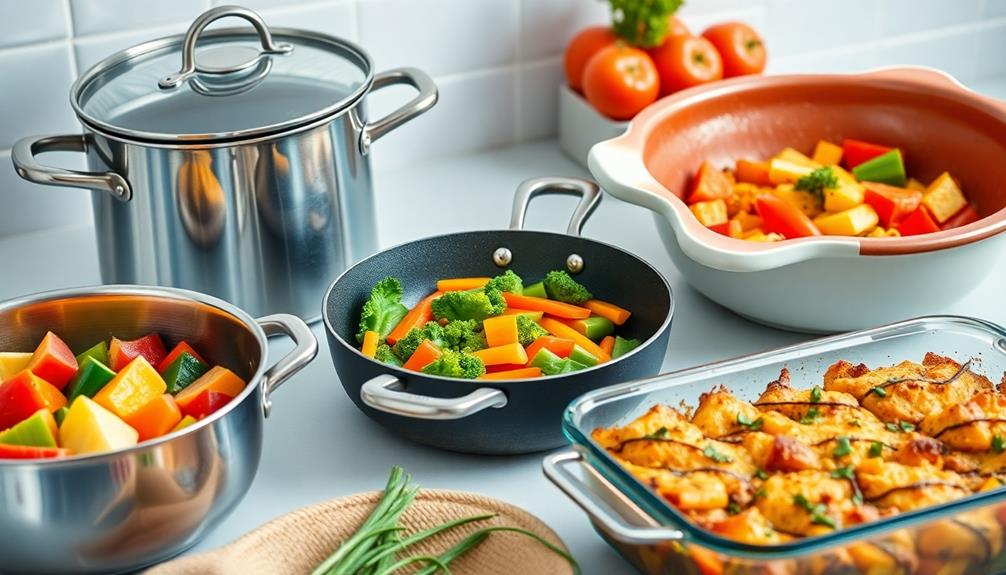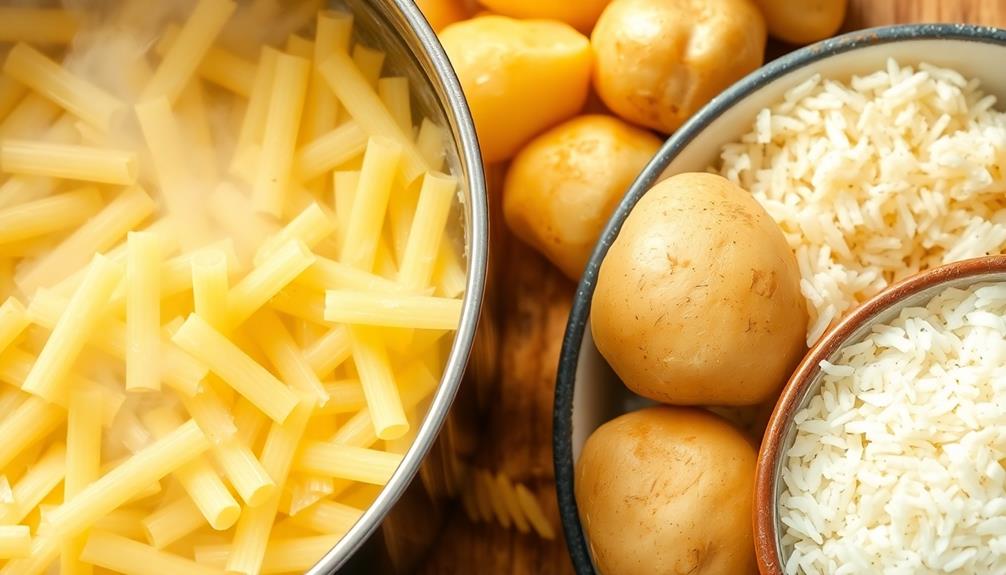The cooking vessels you choose play a vital role in determining the nutritional value of your meals. For instance, titanium pots retain the most nutrients, while aluminum can degrade vitamins due to its reactive nature. Methods like steaming and microwaving are better for preserving nutrients compared to boiling, which can cause significant losses. Stainless steel and cast iron offer varying nutrient retention, impacting your food's health benefits. Regularly evaluating your cookware and opting for better methods can maximize the nutritional quality of your diet. Explore further to uncover even more tips for healthier cooking practices.
Key Takeaways
- Cooking vessels made from different materials, like titanium and aluminum, significantly affect nutrient retention in foods.
- Steaming and microwaving preserve more nutrients compared to boiling, which can lead to substantial nutrient loss.
- High temperatures and prolonged cooking times destroy sensitive vitamins, particularly in low-quality cookware.
- Titanium pots retain more essential micronutrients than aluminum, which has reactive properties that degrade nutrients.
- Regular assessment and replacement of old cookware can enhance nutritional outcomes in meal preparation.
Overview of Cooking Vessels
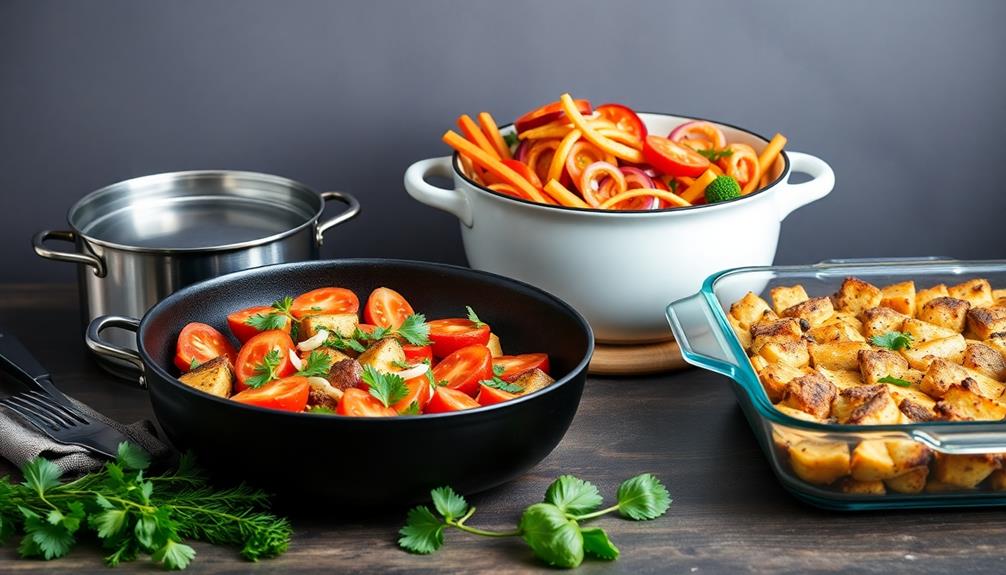
Cooking vessels play an essential role in how we prepare our meals and the nutritional value of the food we consume. The choice of material influences both nutrient retention and cooking efficiency. For instance, titanium pots stand out for their impressive ability to preserve micronutrients, achieving a retention rate of 76.53%. This makes them a superior option compared to older aluminum pots, which often degrade nutrients due to their reactive properties.
Additionally, the cooking techniques employed, such as stewing, can also impact the nutritional profile of the dishes prepared.
When it comes to cooking efficiency, titanium pots require less water and demonstrate lower moisture content, leading to better nutrient preservation during cooking. The design of cooking vessels also plays an important role; those that facilitate vacuum cooking methods can enhance nutrient preservation even further, addressing concerns related to micronutrient deficiencies in diets.
It's important to regularly assess your cooking vessels, particularly aluminum pots, which should be replaced every 2-3 years to avoid nutrient degradation.
Impact of Material on Nutrients
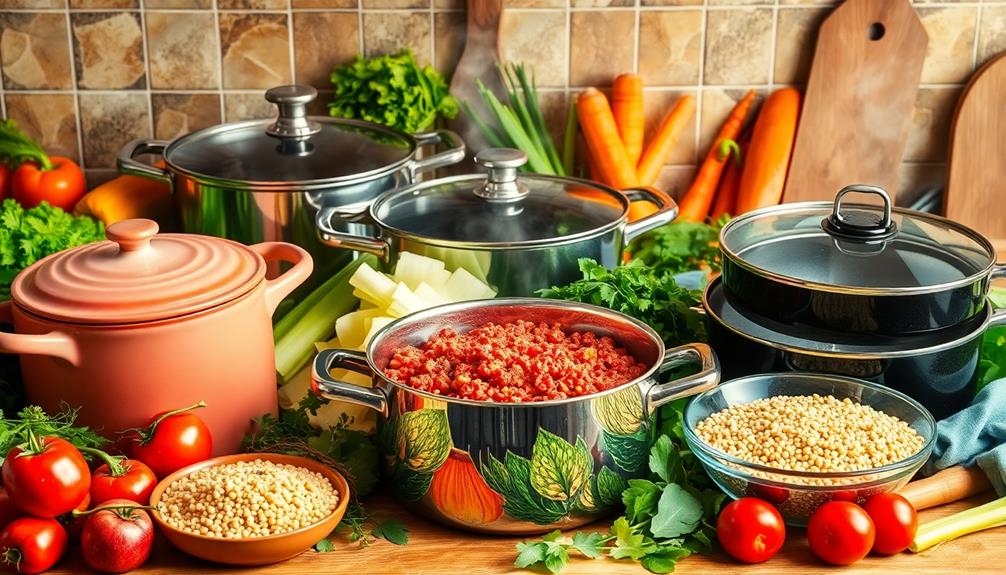
When selecting cooking vessels, the material you choose greatly impacts nutrient retention in your meals. For instance, using titanium pots can be as essential as choosing the right ingredients when preparing traditional dishes like Dorayaki (Red Bean Pancake), which rely on precise cooking techniques to enhance flavors.
Titanium pots, for example, demonstrate exceptional performance, achieving up to 76.53% retention of essential minerals. In contrast, older aluminum pots retain only 68.45% of vitamin A, highlighting a substantial difference in nutritional value.
Cooking in titanium pots not only preserves minerals but also maintains higher levels of vitamin C, B vitamins, and selenium. These advantages stem from the material's unique properties, which minimize nutrient loss during cooking.
Additionally, titanium pots require less water—68.67%—compared to aluminum pots, which need 77.89%, further enhancing nutrient retention.
The structural differences between cooking vessels, such as their heat conductivity and reactivity, also play a critical role in how nutrients degrade. Materials with high thermal diffusivity can lead to quicker nutrient loss, so choosing the right pot material is essential.
If you want to maximize the nutritional value of your meals, opting for titanium pots over aluminum pots can make a significant difference, ensuring that you get the most out of your cooking.
Cooking Methods and Nutrient Retention
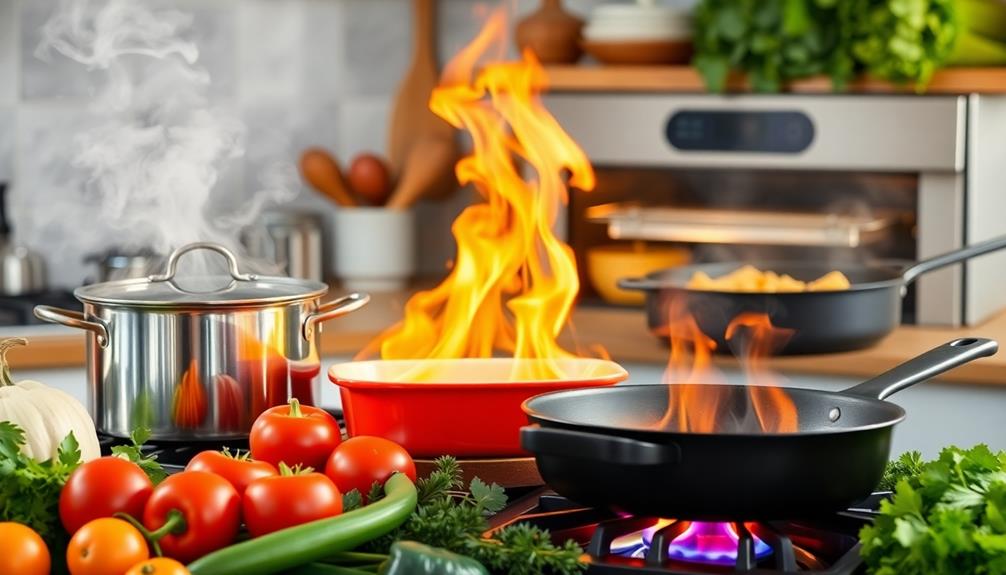
When you cook, the method you choose can greatly affect the nutrients in your food.
For instance, boiling can cause significant losses of water-soluble vitamins, while steaming helps retain more of those essential nutrients.
Some traditional Chinese dishes, such as Chinese Steamed Egg, utilize steaming to preserve natural flavors and nutrients.
Understanding the best cooking techniques can really make a difference in your meals' nutritional value.
Impact of Cooking Methods
Many people may not realize how much cooking methods can affect the nutritional value of their meals. The way you cook can markedly influence nutrient retention, especially when it comes to water-soluble vitamins.
For instance, steaming is one of the best cooking methods, preserving about 85-91% of these essential nutrients, while boiling can cause nutrient loss of up to 50% in vegetables.
Water-based techniques, like simmering, tend to extract more vitamins, leading to higher losses. On the other hand, dry heat methods, such as grilling and roasting, may cause around 40% loss of B vitamins, but they can enhance flavor while retaining fat-soluble vitamins effectively.
Sautéing and stir-frying are beneficial, as they not only preserve B vitamins but also improve the absorption of fat-soluble vitamins. For example, stir-frying carrots can increase beta carotene absorption by 6.5 times compared to consuming them raw.
Nutrient Loss Mechanisms
Cooking methods play an essential role in determining how much of the meal's nutrients you actually get. High cooking temperatures and prolonged exposure to air and light can lead to significant vitamin loss, especially for sensitive nutrients like vitamins C and B.
For instance, boiling vegetables can cause losses exceeding 50% of B vitamins, while steaming can preserve up to 91% of vitamin C. This highlights the importance of selecting the right cooking methods for ideal nutrient retention.
The quality of your cookware also matters. Using low-quality materials, like old aluminum pots, can exacerbate nutrient degradation. In contrast, titanium cookware can retain up to 96.31% of vitamin A, showcasing the benefits of investing in better cookware.
Additionally, the moisture content of your food plays a vital role. Foods cooked with less moisture tend to retain more minerals and vitamins, as excessive water can leach nutrients away.
Optimal Cooking Techniques
Effective cooking techniques can considerably impact the nutrient retention in your meals, guaranteeing you get the most out of your ingredients. To maximize nutrient retention, focus on cooking methods that minimize vitamin losses. For instance, steaming and microwaving generally preserve more nutrients than boiling, which can lead to substantial losses.
Here's a quick comparison of common cooking methods and their impact on nutrient retention:
| Cooking Method | Nutrient Retention (%) |
|---|---|
| Steaming | 85-91% of Vitamin C |
| Boiling | Up to 40% of B Vitamins |
| Stir-frying | 6.5x Beta-Carotene absorption |
Using titanium pots can further enhance nutrient retention, helping retain up to 96.31% of vitamin A. Remember, high temperatures and prolonged cooking times can lead to significant degradation of nutrients, particularly B vitamins. Opt for water-based cooking techniques judiciously, as they can result in a 60% loss of B vitamins. By adopting ideal cooking techniques, you'll guarantee that your meals are not only delicious but also packed with essential nutrients, especially fat-soluble vitamins.
Effects of Temperature and Time

When you cook, the temperature and time can drastically affect the nutritional value of your food.
Higher temperatures and longer cooking times often lead to significant nutrient loss, especially for heat-sensitive vitamins.
Optimal Cooking Temperatures
Understanding ideal cooking temperatures is essential for preserving the nutritional value of your food. Cooking at high temperatures can destroy sensitive nutrients, particularly water-soluble vitamins like vitamin C and B vitamins. For instance, boiling vegetables for extended periods can lead to significant nutrient loss—up to 60% of B vitamins. Instead, aim for superior cooking temperatures, such as steaming vegetables at around 212°F (100°C), which typically results in only 9-15% vitamin C loss.
When preparing meats, guarantee safety by cooking poultry to at least 165°F (75°C), which retains more nutrients than higher temperatures. Cooking methods that utilize dry heat, like roasting and baking, generally offer better nutrient retention, although B vitamins may decline by approximately 40% with prolonged exposure to high temperatures.
Here's a quick overview of cooking methods and their effects on nutrient retention:
| Cooking Method | Superior Temperature | Nutrient Loss (%) |
|---|---|---|
| Steaming | 212°F (100°C) | 9-15% |
| Boiling | Varies | Up to 60% |
| Roasting/Baking | Varies | ~40% |
| Grilling | Varies | ~40% |
Cooking Time Impact
Cooking time plays an essential role in how well your food retains its nutrients. The longer the cooking time and the higher the temperature, the more likely you're to lose important nutrients like vitamin C. For instance, boiling vegetables can cause up to a 50% loss of vitamin C content, while steaming retains around 85-91% of it. This highlights how different cooking methods impact nutrient retention.
If you're using high heat for extended periods, you're risking significant reductions in fundamental micronutrients. For example, vitamin A can decline by as much as 40% under these conditions. It's critical to reflect on how cooking time affects nutrient preservation.
Even high atmospheric pressure, which raises boiling points, can lead to increased nutrient loss.
On the other hand, quick cooking methods like microwaving allow for shorter exposure times, helping retain more vitamins than boiling or frying. If you want to maximize nutrient retention, focus on cooking your foods at lower temperatures and for shorter durations.
Heat Sensitivity of Nutrients
Heat-sensitive nutrients often suffer significant losses due to high temperatures and prolonged cooking times. When you use traditional cooking methods like boiling, you can lose up to 60% of heat-sensitive vitamins such as B vitamins, especially when cooking at temperatures above 100°C. Prolonged cooking times can further diminish vitamin C retention by as much as 50%. This highlights the importance of using shorter cooking durations to preserve these essential nutrients.
Additionally, the type of cooking vessel matters. High thermal diffusivity materials, like old aluminum pots, can exacerbate nutrient loss by transferring heat more quickly, leading to greater degradation of sensitive nutrients.
If you cook under high atmospheric pressure, the boiling point increases, which can further elevate nutrient loss, particularly for heat-sensitive vitamins.
To combat these issues, consider utilizing vacuum cooking methods. These techniques maintain lower cooking temperatures and shorter exposure times, effectively reducing nutrient degradation.
Comparison of Common Cooking Pots
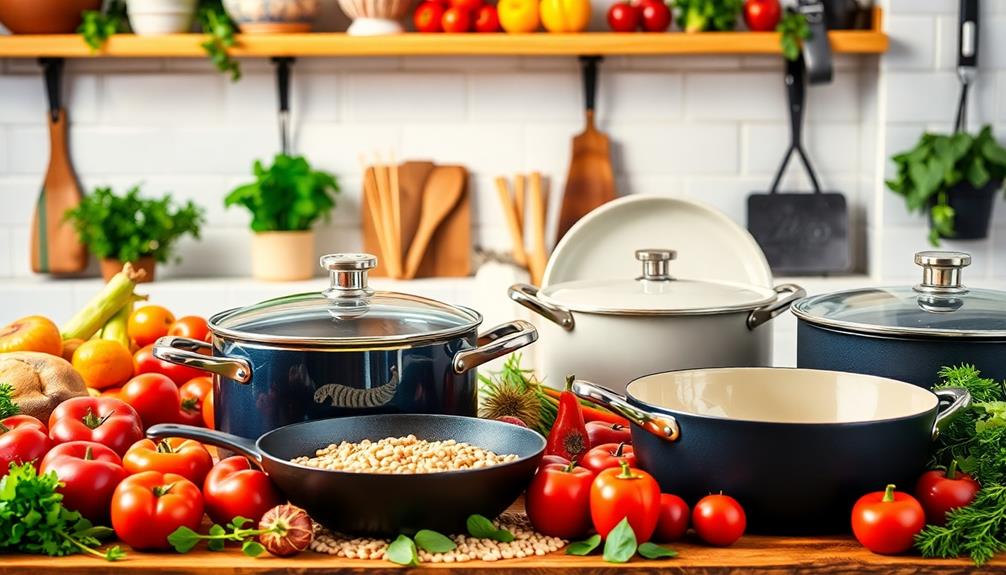
When it comes to choosing the right cooking pot, the material can make a significant difference in nutrient preservation. Your choice of cookware affects nutrient retention and can lead to varying levels of micronutrient loss. Here's a quick comparison of common cooking pots:
| Pot Material | Micronutrient Retention | Vitamin A Retention |
|---|---|---|
| Titanium Pots | 76.53% | 96.31% |
| Aluminum Pots | Low (old pots) | 68.45% |
| Stainless Steel | Moderate | Moderate |
Titanium pots stand out for their ability to retain nutrients, while old aluminum pots, which should be replaced every 2-3 years, show a significant decline in nutrient preservation. Cooking conditions play an essential role; prolonged heating in open pots leads to even greater nutrient loss. By opting for titanium cookware, you not only enhance nutrient retention but also enjoy better overall cooking performance. Remember, the right pot can make all the difference in how well your meals retain their essential vitamins and minerals!
Nutrient Loss in Specific Foods
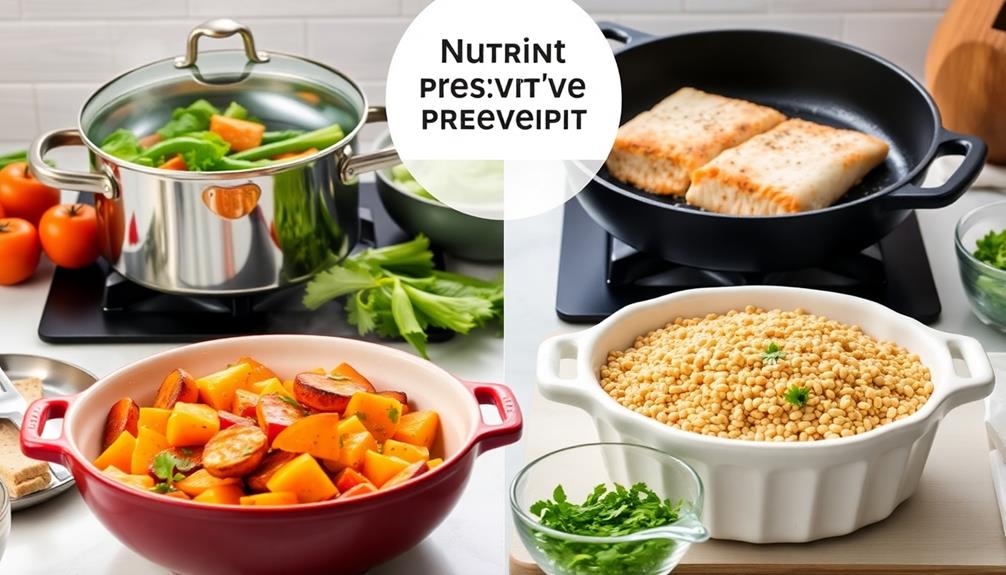
The choice of cooking vessel can directly impact the nutrient retention of specific foods. When you cook vegetables in old aluminum pots, you might face notable nutrient loss, with vitamin retention plummeting to as low as 68.45%.
In contrast, using titanium pots can boost vitamin A retention to an impressive 96.31%. Boiling cruciferous vegetables like broccoli often leads to decreased glucosinolates, while steaming them helps preserve more vitamins and minimizes nutrient degradation.
If you're boiling potatoes, be aware that potassium levels can drop considerably, but baking them retains more nutritional content. Cooking tomatoes is interesting, as it can enhance their lycopene content, boosting antioxidant properties.
However, nutrient retention varies greatly depending on the cooking vessel you choose. Lastly, nutrient loss from water-soluble vitamins, such as vitamin C and B vitamins, can reach up to 60% when you opt for boiling methods in low-quality cookware.
This underscores how vital the choice of cooking vessels is for maintaining nutrient retention in your meals. By being mindful of your cookware, you can help guarantee you're getting the most out of your food.
Recommendations for Healthier Cooking
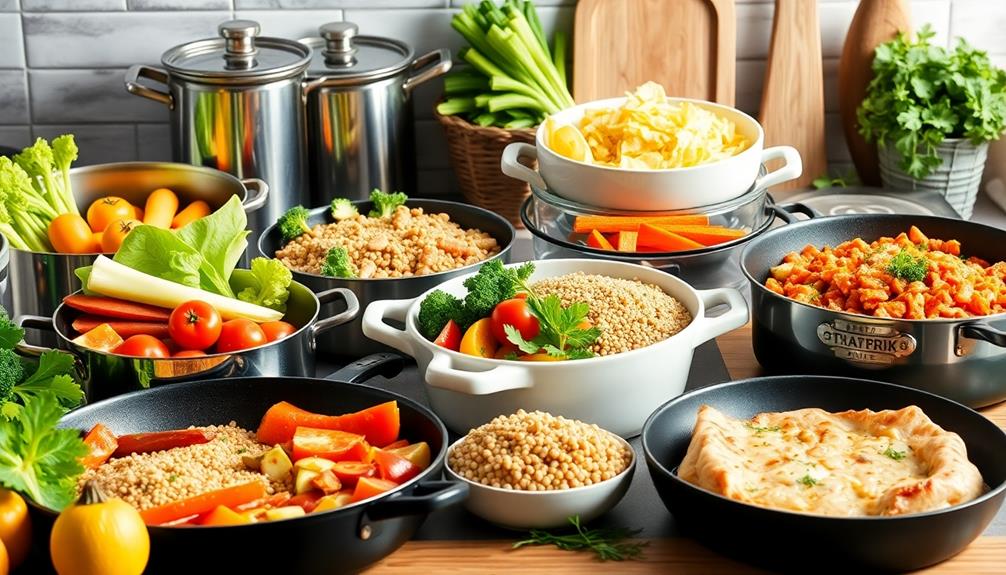
Choosing the right cooking methods and vessels can greatly boost the nutritional quality of your meals. Start by investing in titanium cooking pots, which excel in nutrient preservation. They retain over 96% of vitamin A, compared to just 68.45% in old aluminum pots, making a noticeable difference in your diet.
When it comes to cooking methods, opt for steaming or microwaving instead of boiling. These methods minimize nutrient loss, preserving up to 91.1% of vitamin C, while boiling can cause a staggering 50% loss.
You'll also want to minimize water usage during cooking. High moisture content often leads to diminished taste and nutritional value, so cooking with less water can help retain essential minerals and vitamins.
Regularly replace old aluminum pots every 2-3 years to guarantee you're not sacrificing nutrient quality due to their reactive properties.
Finally, consider utilizing vacuum cooking methods. They create a sealed environment that reduces exposure to air and light, greatly enhancing nutrient preservation.
Importance of Cooking Techniques
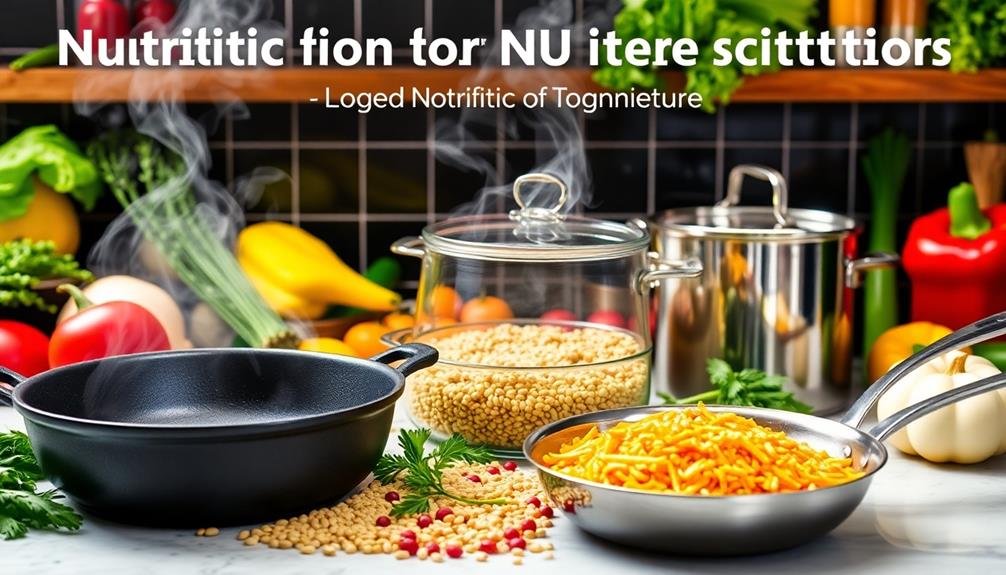
Effective cooking techniques can dramatically influence the nutritional value of your meals. The choice of cooking methods plays an essential role in nutrient retention. For instance, steaming helps retain up to 91.1% of vitamin C, while boiling can lead to losses exceeding 50%.
If you sauté in healthy fats, you can enhance the absorption of fat-soluble vitamins like A, D, E, and K, whereas boiling often strips away water-soluble vitamins such as B and C.
It's important to note that high cooking temperatures can destroy sensitive nutrients. Overcooking may result in a 40% loss of B vitamins, so keeping an eye on the cooking time is vital. Techniques like microwaving are effective in retaining more nutrients due to shorter cooking durations, often outperforming traditional boiling.
Additionally, the right cooking technique can improve the bioavailability of nutrients. For example, cooking carrots increases beta-carotene absorption by 6.5 times compared to eating them raw.
Future Research Directions

Exploring future research directions in cooking vessels can lead to significant advancements in our understanding of nutrient retention. You should consider focusing on the comparative nutrient retention capabilities of various cooking pot materials, like titanium, stainless steel, and aluminum. By examining how these materials affect vitamin and mineral preservation across different cooking methods, you can uncover vital insights.
Additionally, investigating how pot design—such as lid usage and shape—impacts nutrient loss could optimize your cooking practices. It's important to explore the long-term health implications of nutrient loss for populations that rely heavily on specific pot materials, especially in developing regions facing micronutrient deficiencies.
Researching innovative cooking methods, including vacuum cooking and waterless techniques, can also reveal new strategies for enhancing dietary quality. Establishing standardized protocols to measure true retention values of nutrients from various cooking pots will enable you to better compare and recommend healthier cooking practices.
Frequently Asked Questions
How Do Different Cooking Methods Affect the Nutritional Value?
Different cooking methods can considerably impact nutritional value. Boiling often leads to nutrient loss, while steaming retains more vitamins. Microwaving is efficient, and stir-frying boosts absorption. Choosing the right method preserves nutrients in your meals.
Which Vessel Is Healthy for Cooking?
When choosing a cooking vessel, you should opt for high-quality materials like titanium or stainless steel. They retain nutrients better, enhance flavors, and contribute positively to your overall health compared to reactive options like aluminum.
How Does Pan Frying Affect the Nutritional Value of Food?
Pan frying affects nutritional value by potentially degrading water-soluble vitamins. However, using high-quality cookware and healthy oils can enhance nutrient retention and absorption, helping you maintain better overall food quality while enjoying delicious meals.
How Do Different Cooking Methods Affect the Sensory Qualities of Root Vegetables?
Different cooking methods greatly impact the sensory qualities of root vegetables. Steaming preserves color and texture, while roasting enhances sweetness. Sautéing in healthy fats boosts flavor, and microwaving retains taste and nutrients effectively. Choose wisely!
Conclusion
To sum up, the cooking vessel you choose can greatly influence the nutritional value of your meals. For instance, studies show that cooking in non-stick pans can reduce nutrient loss by up to 20% compared to metal pots. By being mindful of the materials and methods you use, you can boost the nutrients in your food. So next time you're in the kitchen, think about how your cookware affects your health—and make those small changes for a big impact!
